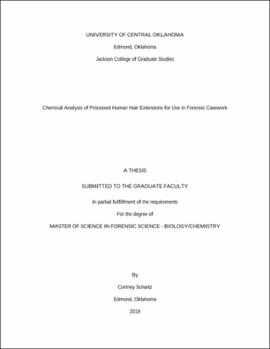| dc.contributor.advisor | Jourdan, Thomas | |
| dc.contributor.author | Schartz, Courtney. | |
| dc.date.accessioned | 2020-07-09T14:41:03Z | |
| dc.date.available | 2020-07-09T14:41:03Z | |
| dc.date.issued | 2019 | |
| dc.identifier.other | (AlmaMMSId)9982666785102196 | |
| dc.identifier.uri | https://hdl.handle.net/11244/325109 | |
| dc.description.abstract | In forensic laboratories, hair analysis is performed in the trace evidence unit and the DNA unit. The completed analysis of hair can include a variety of tests, but generally, microscopic analysis is performed and is followed by mitochondrial DNA analysis. With the increasing use of hair extensions, it is possible that a hair sample discovered at a crime scene may be a processed human hair extension and has no physical or genetic connection to the individual wearing the hair extensions. This can be misleading in an investigation and result in a misuse of time and resources. Being able to identify a hair as a processed human hair extension is valuable in determining its entire evidentiary value and result in the forensic laboratory adjusting its approach to analysis. Current literature is limited pertaining to hair extensions as forensic evidence. Only one study has focused extensively on processed human hair extensions for their probative value in forensic case work. This study involved the microscopic examination and genetic analysis of processed human hair extensions but found no features that differentiated natural human head hairs from human hair extensions. There are multiple articles that research chemical analysis of hair, but few are looking into applications into the forensic laboratory. The lack of literature proves the necessity for this research.This research determined whether a chemical difference was present between natural human head hair and processed human hair extensions through ultraviolet-visible spectroscopy, gas chromatography/mass spectrometry, and nuclear magnetic resonance spectroscopy. Three different hair extension brands and five different natural human hair samples were used in this research. Multiple organic solid-liquid extractions were completed using hexanes, Colorist SecretsTM Hair Color Remover, methanol, 1-octanol, and chloroform-d. The extraction solvents were then used for instrumental analysis by ultraviolet-visible spectroscopy, gas chromatography/mass spectrometry, and nuclear magnetic resonance spectroscopy. The resulting spectra were analyzed and compared to determine differences between processed human hair extensions and natural human head hairs. This study proves that there is a chemical difference between processed human hair extensions and natural human head hair. This was indicated by the differences observed in spectra on the UV-Vis, GC/MS, and NMR between the natural human head hairs and processed human hair extensions. The processed human hair extensions have a higher absorbance, when analyzed with UV-Vis spectroscopy than the natural human head hair samples. In addition, there are specifics in the processed human hair extensions that are visualized by GC/MS and NMR analysis that are not present in the control natural human head hair samples. The higher absorbance and peaks show a chemical difference between the samples. This chemical difference can be used to differentiate samples in a forensic laboratory, which could change how hair is analyzed for casework. This research is significant because it allows for the chemical identification of processed human hair extensions which may help in determining if the hair has probative value in a forensic case. The ability to chemically identify a hair extension collected from a crime scene would provide investigate leads and help to preserve time and resources. Also, chemical analysis might allow a processed human hair extension collected from a crime scene to be definitively associated with others from the same manufacturing package. This would be beneficial if the extensions were still attached to the suspect's head. This research has the potential to change the way that hair analysis is viewed and used throughout the forensic laboratory. Further research needs to be completed: analysis of more hair extension brands, determine a concise method of analysis, and the best extraction solvent. The study is a precursor to all of this and proves that there is a necessity for further analysis and implementation to forensics. But before any of that can happen, a reliable and consistent method needs to be determined and validated. This study proves this need for further research in this area, and ultimately updating the process for hair analysis throughout forensic laboratories. | |
| dc.rights | All rights reserved by the author, who has granted UCO Chambers Library the non-exclusive right to share this material in its online repositories. Contact UCO Chambers Library's Digital Initiatives Working Group at diwg@uco.edu for the permission policy on the use, reproduction or distribution of this material. | |
| dc.subject.lcsh | Chemistry, Forensic | |
| dc.subject.lcsh | Hair extensions | |
| dc.title | Chemical analysis of proecessed human hair extentions for use in forensic casework. | |
| dc.type | Academic theses | |
| dc.contributor.committeeMember | Creecy, James | |
| dc.contributor.committeeMember | Porterfield, Caitlin | |
| dc.contributor.committeeMember | Skiles, Stephanie | |
| dc.thesis.degree | M.S., Forensic Science - Biology/Chemistry | |
| dc.subject.keywords | Chromatography | |
| dc.subject.keywords | Processed human hair extensions | |
| dc.subject.keywords | Spectroscopy | |
| dc.identifier.oclc | (OCoLC)1112074210 | |
| uco.group | UCO - Graduate Works and Theses::UCO - Theses | |
| thesis.degree.grantor | Jackson College of Graduate Studies. | |
